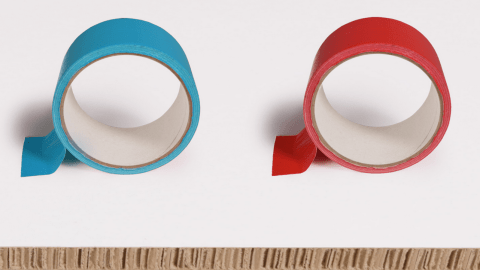The Future of Furniture is Paper and Tape

What is the future of furniture? Paper and tape. At least that is the solution coming from Bulgarian designer Petar Zaharinov, whose latest line of furniture is made entirely and solely of these two components. Having always been inspired by puzzles and “things that seem impossible”, he introduces a simple way of attaching planes together with duct tape in a chess pattern, which allows him to create sturdy, foldable tables, desks, chairs, book shelves, beds, and even storage bins.

“I wanted to provoke those who think that the only possible future is super high-tech, with artificial intelligence and wi-fi built in everything. I think this will be only one part of it. The other will be extreme simplicity and customization. I don’t think that people will stop using massive furniture, but for the modern person who travels a lot and changes their location every few years, this may be a great solution.”
The idea for TapeFlips came to Petar during his preparation for an international design competition exploring the topic of “Anti-fragility”. After reading Nassim Taleb’s Antifragile: Things That Gain from Disorder, Petar was intrigued by the question how to create furniture that didn’t suffer from the passage of time.
“According to Taleb, we are living in an age that is constantly changing and increasingly hard to predict, so we need to build our lives and our businesses in a way that they gain from that change instead of lose from it. I realized that in order for the entire system to not be fragile, its components needed to be. I used this concept for TapeFlips. I wanted to build a system of furniture where each of the components can be easily transformed, repaired, customized, and adapted. Even the materials needed to be very basic like tape and cardboard.”
The result is creative, innovative, and practical. TapeFlips can adapt easily – rearranging the parts gives you new setups, allows you to adjust dimensions (for example, the height of a desk or chair), and save space. The paper panels are light, waterproof, and the owner can easily print patterns on them. The tape behaves as hinges and ensures a 360 angle of rotation. As for durability, Zaharinov says that a chair, for example, has been tested to hold up to 100 kilos, but as tape is crucial for durability, his team plans to develop their own brand to ensure the quality of each piece.
Currently, TapeFlips biggest fans are environmentally conscious people and organizations, parents, and event organizers. The cardboard is recycled and recyclable. Building the furniture itself is a fun and bonding activity for parents and their kids, and the pieces are light and safe. They are also easy to carry, mobile and versatile, making them perfect for transforming event spaces and store windows.
For now, Petar’s plan is to continue testing the furniture with clients and build a community around the TapeFlips concept. The next stage will be finding an investor in order to begin mass production.
Photos: TapeFlips





